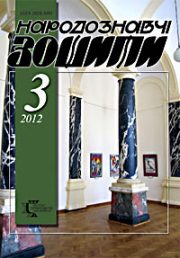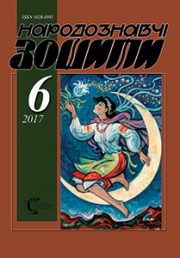The Ethnology Notebooks. 2025. № 3 (183), 566—577
UDK 745.5:7.038.53(477)
DOI https://doi.org/10.15407/nz2025.03.566
BENYAKH Nataliia
- ORCID ID: https://orcid.org/0000-0002-2578-0555
- Candidate of Art Criticism,
- Associate Professor,
- Head of the Department of Art Wood,
- Lviv National Academy of Arts,
- 38, V. Kubiyovycha str., 79011, Lviv, Ukraine,
- Contacts: e-mail: benyakh@lnam.edu.ua
Abstract. Introduction. The evolution of decorative art in Ukraine at the turn of the 20th and 21st centuries demonstrates a noticeable transition from utilitarian craft toward conceptual artistic practice. This transformation is particularly evident in the work of emerging artists who integrate traditional materials such as wood into experimental and contemporary visual formats. The Lviv National Academy of Arts (LNAM), and especially its Department of Artistic Wood, plays a critical role in cultivating this new generation of artists.
Problem Statement. The study addresses the need to explore how wooden sculpture is being redefined by LNAM graduates as a medium of contemporary art, reflecting both material innovation and conceptual depth. While many works remain rooted in traditional craftsmanship, their exhibition contexts, formats, and philosophical underpinnings reflect the aesthetic and discursive concerns of contemporary global art.
Purpose. This article analyzes the exhibition activities and artistic strategies of five LNAM graduates — N. Symotiuk, D. Shavala, Y. Titenkov, A. Savchuk, and I. Soloviov — focusing on how their work redefines wood as a contemporary artistic medium.
Methods. The study applies art-historical analysis, contextual research on exhibition practices, and a comparative review of conceptual frameworks, using institutional archives, catalogues, and relevant publications.
Results. The artists explore diverse sculptural approaches: geometric abstraction (Symotiuk, Savchuk), organic symbolism (Shavala), parametric design (Titenkov), and color-form relations in sacred art (Soloviov). Through exhibitions such as De:forma, Ratio, and Geometry of Color, they elevate wooden sculpture into a medium of contemporary expression and critical reflection.
Conclusion. The article concludes that the Department of Artistic Wood at LNAM provides not only technical training but a platform for conceptual experimentation, fostering integration between material-based disciplines and contemporary artistic trends. As a result, it has been established that wooden sculpture and relief are integrated into the contemporary artistic process. The role of academic art education as a platform for development in the field of material-based practice is also emphasized.
Keywords: artistic woodworking, contemporary art, exhibition practice, wooden sculpture, installation, relief, exhibition projects.
Received 5.06.2025
REFERENCES
- Chehusova, Z. (2005). Ukrainian Decorative Art of the 20th Century. Kyiv: Naukova dumka [in Ukrainian].
- Chehusova, Z.A. (1992). Decorative Art of Ukraine: Traditions, Searches, Stylistic Directions. Kyiv: Mystetstvo [in Ukrainian].
- Yefimova, A., & Novachynskyi, Y. (2020). Reflections of art critics based on the online exhibition archive project of the LNAM Gallery. Visnyk of the Lviv National Academy of Arts, 43, 26—33 [in Ukrainian].
- Lviv National Academy of Arts. (n. d.). Contemporary Decorative Art: Young Generation. Retrieved from: https://lnam.edu.ua/uk/exhibition/suchasne-dekorativne-mistectvo-moloda-generacija.html [in Ukrainian].
- Beniakh, N., & Patyk, O. (2024). Contemporary decorative art in the system of art higher education in Ukraine (based on the activities of the Department of Artistic Wood at the LNAM). Visnyk of the Lviv National Academy of Arts, 52, 19—25. Retrieved from: https://doi.org/10.37131/2524-0943-2024-52-2 [in Ukrainian].
- Stepanok, I. (2025, April 10). Balance between emotions and logic: How the opening of the «RACIO» project took place at the Mercury Art Center in Lviv. Esthet. Retrieved from: https://www.esthetegazeta.com/post/balans-mizh-emociyamy-ta-logikoyu-yak-proyshlo-vidkryttia-proyekty-racio [in Ukrainian].
- Symotiuk, N. (2025, April 12). About. Nazar Symotiuk — Official Website. Retrieved from: https://www.nazarsymotiuk.com/about [in Ukrainian].
- The Center of Intellectual Art Mercury. (2025, June 3). Official website. Retrieved from: https://ciamercury.com/ [in Ukrainian].
- Lviv National Academy of Arts. (2021, May 23). Official website. Retrieved from: https://lnam.edu.ua/uk/home.html [in Ukrainian].
- Shavala, D. (2025, June 3). Official website. Retrieved from: https://dmytroshavala.com/ [in Ukrainian].
- Shavala, D., & Yatsiv, R. (2024). Catalogue of works. Lviv [in Ukrainian].
- Savchuk, A. (2025, June 3). Official website. Retrieved from: https://andriysavchuk.com/ [in Ukrainian].






